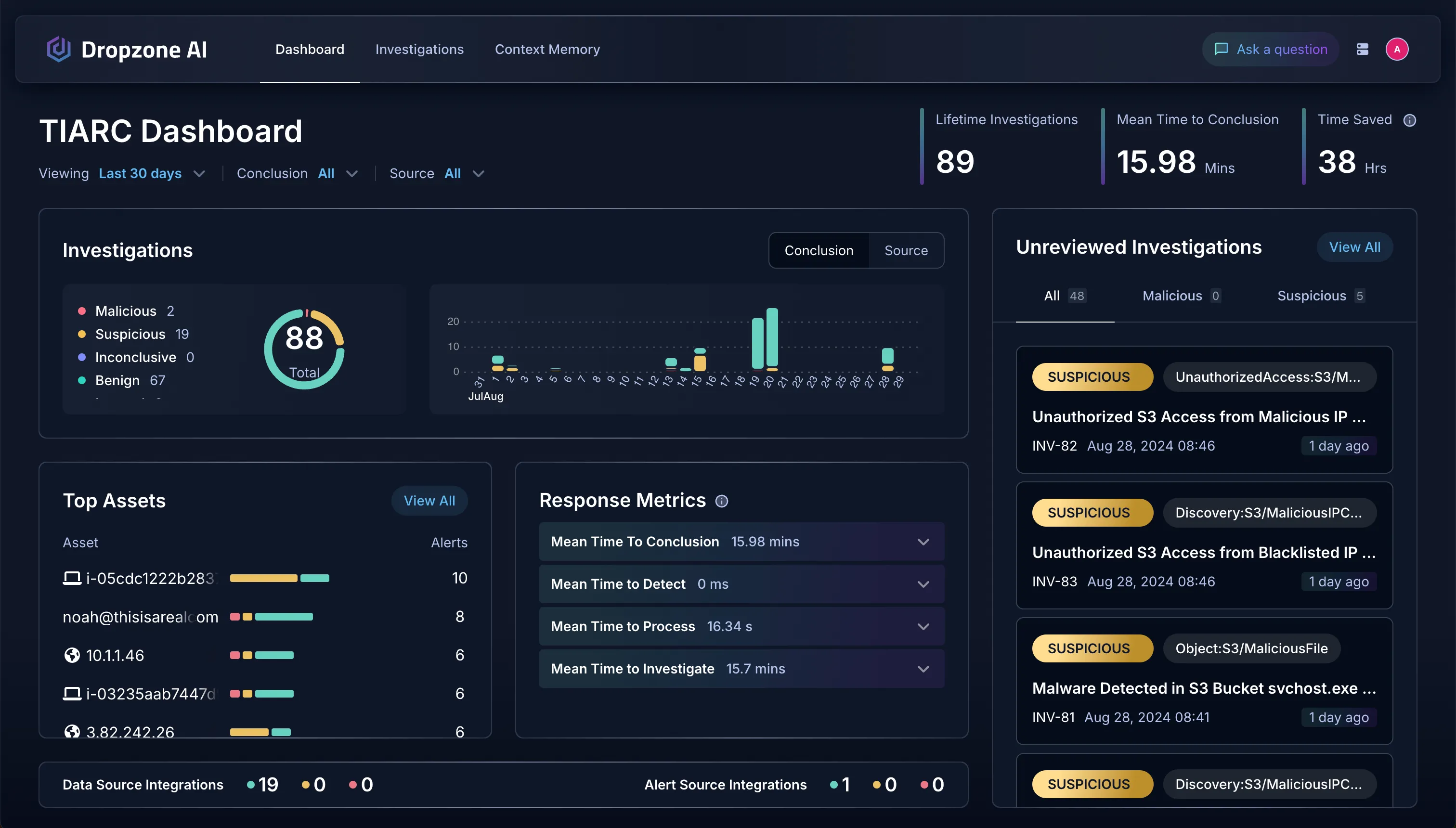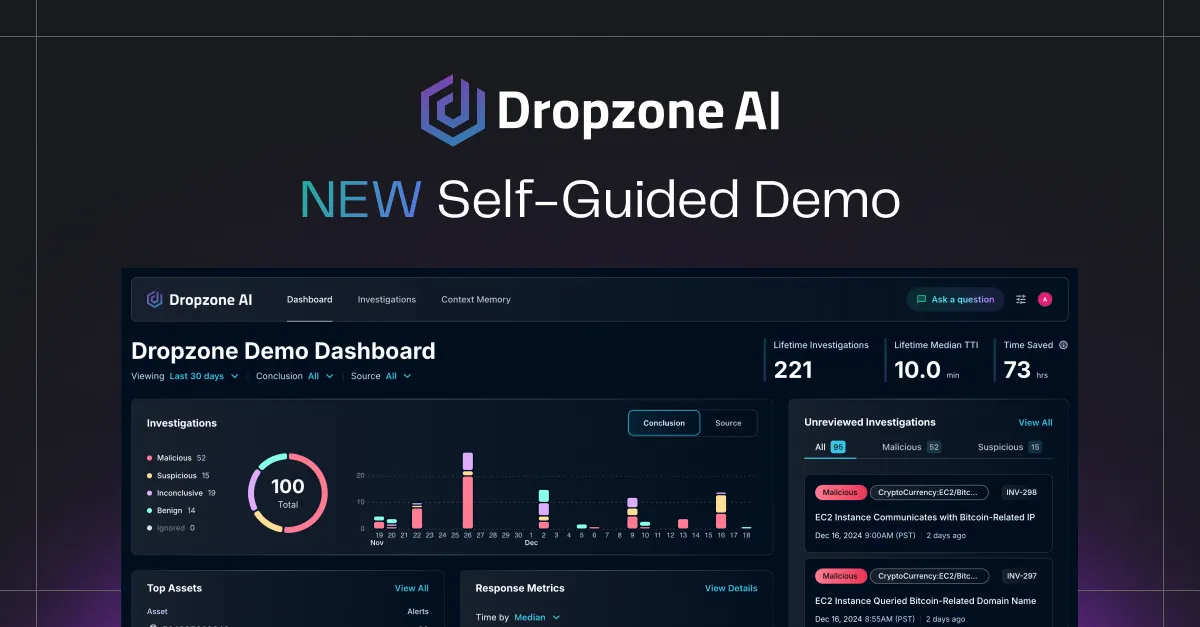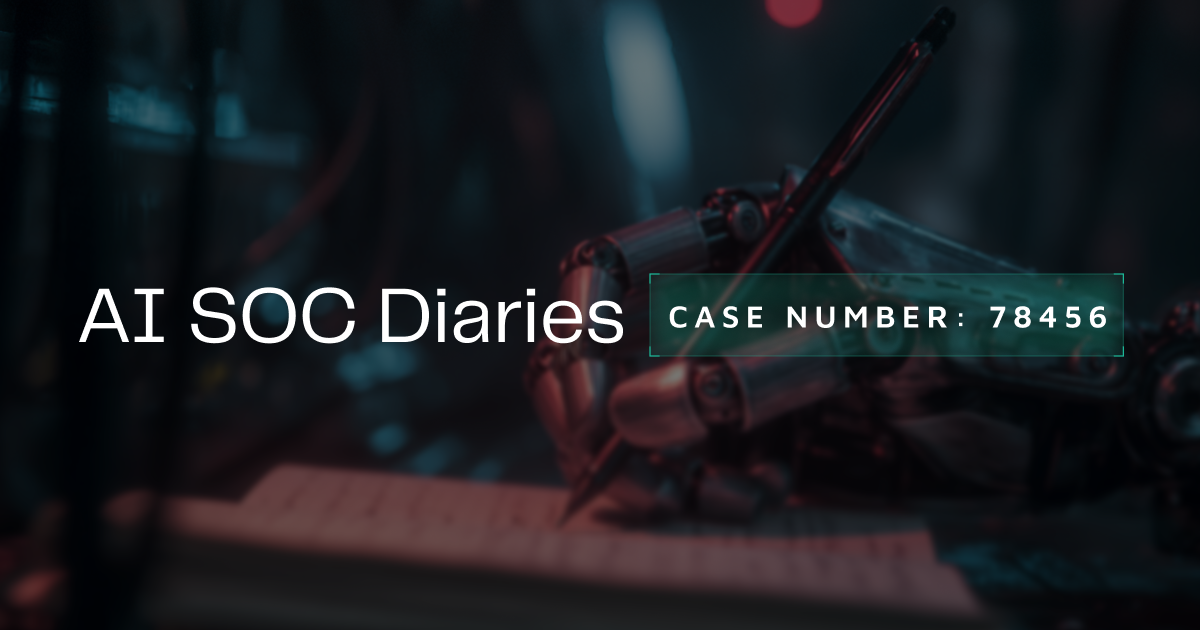SOC teams are drowning in alerts. While metrics like Mean Time to Detect (MTTD) and Mean Time to Respond (MTTR) have served us well for years, they only capture fragments of what's really happening in your security operations. What security teams actually need is a comprehensive measurement – Mean Time to Conclusion (MTTC) – that shows the complete picture of how efficiently alerts are being processed, investigated, and resolved.
Key statistics that highlight the SOC metrics challenge:
- The average SOC analyst faces over 10,000 alerts daily
- Security teams investigate less than 65% of security alerts they receive
- Traditional metrics fail to capture up to 40% of the actual time spent on alert processing
What is Mean Time to Conclusion (MTTC)?
Mean Time to Conclusion (MTTC) measures the entire alert triage lifecycle—from initial detection through final disposition—regardless of whether the alert represents a genuine threat or a false positive. Unlike other SOC performance metrics that focus on specific stages, MTTC provides a holistic view of operational efficiency across all alert types.
MTTC encompasses:
- The moment an alert is generated
- The time until an analyst acknowledges it
- The entire investigation process
- The final decision-making and conclusion
This comprehensive measurement captures both the speed and thoroughness of your security operations, making it the ultimate SOC efficiency metric for modern security teams.
Traditional SOC Metrics: Understanding the Limitations
Before exploring MTTC's advantages, let's examine the traditional SOC metrics that security teams have relied upon:
While each metric provides valuable insight into specific aspects of security operations, none offers the comprehensive view that security leaders need to truly optimize their SOC performance. This is where MTTC transforms your understanding of operational efficiency.
Why Mean Time to Conclusion Matters for Modern SOCs
MTTC addresses critical shortcomings in traditional SOC metrics by:
- Providing complete visibility across the entire alert triage workflow
- Capturing all alert types, not just confirmed incidents
- Identifying bottlenecks in specific stages of alert processing
- Measuring both speed and thoroughness of security operations
- Establishing a baseline for continuous improvement initiatives
For SOC leaders, MTTC delivers actionable insights that directly impact security posture and analyst efficiency. By understanding exactly how long each step in the alert triage process takes, teams can make targeted improvements that reduce overall response times while maintaining investigation quality.
The Anatomy of Mean Time to Conclusion
Understanding MTTC requires breaking down the complete alert triage process:
1. Alert Generation (Detection)
The moment when a security tool flags potentially suspicious activity, starting the clock on MTTC measurement. This corresponds to the traditional MTTD metric but represents only the beginning of the MTTC timeline.
2. Alert Acknowledgment
The period between alert generation and when an analyst or automated system begins processing it. During this stage, alerts often sit in queues waiting for attention—a significant but frequently overlooked contributor to overall response times.
3. Investigation Process
The most time-intensive component of MTTC, investigation involves:
- Understanding the alert context
- Formulating investigative questions
- Gathering relevant data from multiple sources
- Analyzing the findings
- Synthesizing conclusions
4. Decision and Disposition
The final stage where analysts determine whether an alert:
- Represents a false positive requiring no action
- Needs escalation for incident response
- Requires additional investigation
- Reveals a security gap requiring remediation
By measuring the entire process from start to finish, MTTC provides security leaders with the comprehensive metric they need to truly understand SOC performance.

How AI Transforms Mean Time to Conclusion
Artificial intelligence is revolutionizing how SOCs approach alert triage and dramatically reduces MTTC through:
Automated Alert Investigation
AI systems like Dropzone AI can autonomously execute the most time-consuming investigation tasks, including:
- Contextual data gathering across multiple security tools
- Pattern recognition and anomaly detection
- Correlation of related events and activities
- Evidence compilation and analysis
Instant Alert Acknowledgment
AI eliminates the MTTA component almost entirely by:
- Immediately beginning investigation as alerts arrive
- Processing alerts 24/7 without breaks or shift changes
- Handling multiple alerts simultaneously
- Maintaining consistent investigation quality regardless of volume
Accelerated Decision Support
Modern AI provides analysts with:
- Investigation summaries containing all relevant evidence
- Probability assessments based on threat intelligence
- Recommended next actions based on findings
- Complete audit trails of the investigation process

Measuring the Impact: How Dropzone AI Reduces MTTC
Dropzone AI dramatically improves SOC efficiency by automating the most time-consuming aspects of alert triage:
- Alert acknowledgment becomes instant - eliminating queue time entirely
- Investigation time reduces from 20-40 minutes to 3-11 minutes - an 85% improvement
- Decision quality improves through consistent, thorough analysis - reducing security risks
- Analysts can focus on critical thinking rather than data collection - enhancing job satisfaction
By automating routine investigation tasks, Dropzone AI enables security teams to handle significantly higher alert volumes without additional headcount while simultaneously improving investigation quality and consistency.
Implementing MTTC in Your Security Operations
To leverage MTTC as a key SOC performance metric:
- Establish current baselines for each component of your alert triage process
- Identify bottlenecks where alerts experience the greatest delays
- Implement automation for routine investigation tasks
- Set improvement targets for overall MTTC reduction
- Monitor trends to ensure continuous improvement
Organizations that successfully implement MTTC as a core SOC metric typically see:
- Improved threat detection and response times
- Reduced analyst burnout and turnover
- Better allocation of security resources
- Enhanced ability to handle growing alert volumes
- Stronger overall security posture
Conclusion: Making MTTC Your Core SOC Performance Metric
Mean Time to Conclusion represents the most comprehensive and actionable metric for measuring modern SOC performance. By capturing the entire alert triage lifecycle, MTTC provides security leaders with unprecedented visibility into operational efficiency and effectiveness.
As security teams face ever-increasing alert volumes with limited resources, optimizing MTTC becomes essential for maintaining a strong security posture. Through intelligent automation of investigation processes, organizations can dramatically reduce MTTC while improving the consistency and quality of alert handling.
By implementing MTTC as a core performance indicator and leveraging AI-powered tools like Dropzone AI to automate routine investigation tasks, security teams can transform their operations from reactive to proactive—ensuring faster, more consistent, and more thorough threat detection and response.
Ready to Transform Your SOC Performance?
Take the first step toward optimizing your Mean Time to Conclusion and revolutionizing your security operations:
- Schedule a Demo: See how Dropzone AI can reduce your MTTC by up to 90%
- Download Our Free E-Book: "MTTC: KPI for SOC Effectiveness" - Get our comprehensive guide to measuring and improving MTTC
Don't let alert overload compromise your security posture. Discover how Dropzone AI can help your team focus on what matters most while our AI handles the rest.















